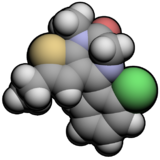 | |
 | |
| Clinical data | |
|---|---|
| Trade names | Veratran, Rize, Clozan |
| AHFS/Drugs.com | International Drug Names |
| Routes of administration | Oral, sublingual, liquid drops |
| ATC code | |
| Legal status | |
| Legal status |
|
| Pharmacokinetic data | |
| Bioavailability | ~90% |
| Metabolism | Hepatic |
| Elimination half-life | 4 hours[2] |
| Excretion | Renal |
| Identifiers | |
| |
| CAS Number | |
| PubChem CID | |
| DrugBank | |
| ChemSpider | |
| UNII | |
| KEGG | |
| ChEMBL | |
| CompTox Dashboard (EPA) | |
| ECHA InfoCard | 100.046.920 |
| Chemical and physical data | |
| Formula | C16H15ClN2OS |
| Molar mass | 318.82 g·mol−1 |
| 3D model (JSmol) | |
| |
| |
| | |

Clotiazepam[3] (marketed under brand name Clozan, Distensan, Trecalmo, Rize, Rizen and Veratran) is a thienodiazepine drug which is a benzodiazepine analog. The clotiazepam molecule differs from benzodiazepines in that the benzene ring has been replaced by a thiophene ring.[4] It possesses anxiolytic,[5] skeletal muscle relaxant,[6] anticonvulsant, sedative properties.[7] Stage 2 NREM sleep is significantly increased by clotiazepam.[8]
- ^ Anvisa (2023-03-31). "RDC Nº 784 - Listas de Substâncias Entorpecentes, Psicotrópicas, Precursoras e Outras sob Controle Especial" [Collegiate Board Resolution No. 784 - Lists of Narcotic, Psychotropic, Precursor, and Other Substances under Special Control] (in Brazilian Portuguese). Diário Oficial da União (published 2023-04-04). Archived from the original on 2023-08-03. Retrieved 2023-08-16.
- ^ "Clotiazépam" (PDF). HAS - Direction de l'Evaluation Médicale. Economique et de Santé Publique. 20 May 2015.
- ^ DE 2107356, Nakanishi M, Kazuhiko A, Tetsuya T, Shiroki M, "Thieno-(2,3-E)(1,4)diazepin-2-ones", issued 3 May 1978, assigned to Yoshitomi Pharmaceutical Industries, Ltd.
- ^ Niwa T, Shiraga T, Ishii I, Kagayama A, Takagi A (September 2005). "Contribution of human hepatic cytochrome p450 isoforms to the metabolism of psychotropic drugs". Biological & Pharmaceutical Bulletin. 28 (9): 1711–1716. doi:10.1248/bpb.28.1711. PMID 16141545.
- ^ Klicpera C, Strian F (May 1978). "Autonomic perception and responses in anxiety-inducing situations". Pharmakopsychiatrie, Neuro-Psychopharmakologie. 11 (3): 113–120. doi:10.1055/s-0028-1094569. PMID 27828.
- ^ Fukuda T, Tsumagari T (August 1983). "Effects of psychotropic drugs on the rage responses induced by electrical stimulation of the medial hypothalamus in cats". Japanese Journal of Pharmacology. 33 (4): 885–890. doi:10.1254/jjp.33.885. PMID 6632385.
- ^ Mandrioli R, Mercolini L, Raggi MA (October 2008). "Benzodiazepine metabolism: an analytical perspective". Current Drug Metabolism. 9 (8): 827–844. doi:10.2174/138920008786049258. PMID 18855614.
- ^ Nakazawa Y, Kotorii M, Oshima M, Horikawa S, Tachibana H (October 1975). "Effects of thienodiazepine derivatives on human sleep as compared to those of benzodiazepine derivatives". Psychopharmacologia. 44 (2): 165–171. doi:10.1007/BF00421005. PMID 709. S2CID 13365554.